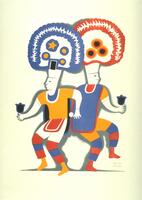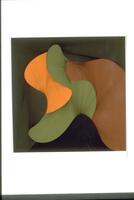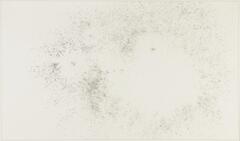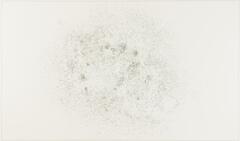12 UMMA Objects
12 UMMA Objects

Joan Miró (Spanish (culture or style))
Personnage
1943 – 1953
Given by their family in memory of Clement A. and Margaret Earhart Smith
1990/1.269
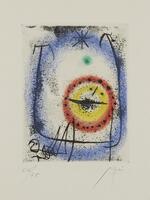
Joan Miró (Spanish (culture or style))
Le Prophète
1958
Gift of Dr. Seymour and Barbara K. Adelson
2015/2.19

Joan Miró (Spanish (culture or style))
XVI Bague d'Aurore
1952 – 1983
Gift of the Marvin Felheim Collection
1983/1.335
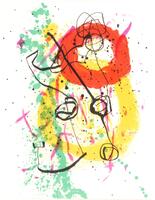
Joan Miró (Spanish (culture or style))
Cercle Rouge
1948 – 1983
Gift of J. Frederick Hoffman
2005/1.439
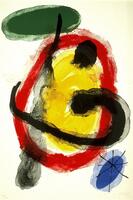
Joan Miró (Spanish (culture or style))
Peintures murales
1961
Gift of Mr. and Mrs. Homer Kripke
1964/2.143
![In this strongly vertical composition, a street crowded with groups of people and individuals—all rendered in silhouette and casting long shadows—recedes into space, seen from above. The street is lined with two- and, at most, four-story buildings on both sides. A hilly landscape rises behind the buildings, and a stormy-looking sky occupies the top portion of the image. In the right foreground, a woman is seen from the back as she stands on a small balcony looking down the street at a procession underway. The procession follows a banner depicting a saint, and proceeds towards the viewer. Some of the people in the street wear pointed hoods over their heads.<br />
The image is covered with diagonal slash marks. The print shows incredibly rich textural effects as a result of intense drypoint scraping, extensive biting in the darkest areas, and printing on very thick wove paper. <br />
Signed in the plate, l.l., recto, "Bone / 19[?]5" In this strongly vertical composition, a street crowded with groups of people and individuals—all rendered in silhouette and casting long shadows—recedes into space, seen from above. The street is lined with two- and, at most, four-story buildings on both sides. A hilly landscape rises behind the buildings, and a stormy-looking sky occupies the top portion of the image. In the right foreground, a woman is seen from the back as she stands on a small balcony looking down the street at a procession underway. The procession follows a banner depicting a saint, and proceeds towards the viewer. Some of the people in the street wear pointed hoods over their heads.<br />
The image is covered with diagonal slash marks. The print shows incredibly rich textural effects as a result of intense drypoint scraping, extensive biting in the darkest areas, and printing on very thick wove paper. <br />
Signed in the plate, l.l., recto, "Bone / 19[?]5"](/media/W1siZiIsIjIwMjIvMDUvMjUvMmtwOTZvdnV4Y19kZWZhdWx0LmpwZyJdLFsicCIsInRodW1iIiwiMjQweDIwMCJdXQ?sha=c198c6fcc0b214aa)
Sir Muirhead Bone (British (modern))
A Spanish Good Friday
1925
Gift of Dr. Thomas DeKornfeld
1985/2.15
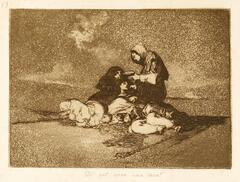
Francisco José de Goya y Lucientes
De que sirve una taza (What is the use of a cup?)
Gift of Clan Crawford, Jr.
2009/1.479
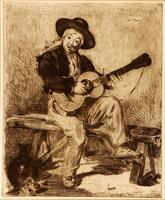
Édouard Manet (French (culture or style))
Le Chanteur Espinol ou le Guittarrero
Gift of Ruth W. and Clarence J. Boldt, Jr.
2008/2.404
Loading…
